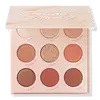What's inside
What's inside
 Key Ingredients
Key Ingredients

No key ingredients
 Benefits
Benefits

No benefits
 Concerns
Concerns

 Ingredients Side-by-side
Ingredients Side-by-side

Zinc Stearate
Cosmetic ColorantSynthetic Fluorphlogopite
Polymethylsilsesquioxane
Magnesium Stearate
Cosmetic ColorantBoron Nitride
AbsorbentDimethicone
EmollientCaprylic/Capric Triglyceride
MaskingPhenoxyethanol
PreservativeCaprylyl Glycol
EmollientEthylhexylglycerin
Skin ConditioningHexylene Glycol
EmulsifyingDimethiconol
EmollientIron Oxides
Mica
Cosmetic ColorantCI 77891
Cosmetic ColorantEthylhexyl Isononanoate
EmollientTrimethylsiloxysilicate
EmollientAlumina
AbrasiveDimethicone Crosspolymer
Emulsion StabilisingIsopropyl Myristate
EmollientCetyl Dimethicone
EmollientStearalkonium Hectorite
Gel FormingTin Oxide
AbrasivePropylene Carbonate
SolventCI 75470
Cosmetic ColorantCI 77491
Cosmetic ColorantTalc
AbrasiveLauroyl Lysine
Skin ConditioningSilica
AbrasiveCI 16035
Cosmetic ColorantCI 19140
Cosmetic ColorantCalcium Sodium Borosilicate
Magnesium Myristate
Aluminum Starch Octenylsuccinate
AbsorbentCI 42090
Cosmetic ColorantZinc Stearate, Synthetic Fluorphlogopite, Polymethylsilsesquioxane, Magnesium Stearate, Boron Nitride, Dimethicone, Caprylic/Capric Triglyceride, Phenoxyethanol, Caprylyl Glycol, Ethylhexylglycerin, Hexylene Glycol, Dimethiconol, Iron Oxides, Mica, CI 77891, Ethylhexyl Isononanoate, Trimethylsiloxysilicate, Alumina, Dimethicone Crosspolymer, Isopropyl Myristate, Cetyl Dimethicone, Stearalkonium Hectorite, Tin Oxide, Propylene Carbonate, CI 75470, CI 77491, Talc, Lauroyl Lysine, Silica, CI 16035, CI 19140, Calcium Sodium Borosilicate, Magnesium Myristate, Aluminum Starch Octenylsuccinate, CI 42090
Dimethicone
EmollientDimethicone/Vinyl Dimethicone Crosspolymer
Skin ConditioningDimethicone Crosspolymer
Emulsion StabilisingPolymethylsilsesquioxane
Vp/Hexadecene Copolymer
Tribehenin
EmollientPolyglyceryl-2 Triisostearate
EmulsifyingDiisostearyl Malate
EmollientSorbitan Sesquiisostearate
EmulsifyingCI 77120
Cosmetic ColorantGlyceryl Caprylate
EmollientAluminum Hydroxide
EmollientCaprylyl Glycol
EmollientEthylhexylglycerin
Skin ConditioningParfum
MaskingTriethoxycaprylylsilane
Water
Skin ConditioningCI 77492
Cosmetic ColorantCI 77891
Cosmetic ColorantCI 73360
Cosmetic ColorantCI 77499
Cosmetic ColorantCI 15850
Cosmetic ColorantDimethicone, Dimethicone/Vinyl Dimethicone Crosspolymer, Dimethicone Crosspolymer, Polymethylsilsesquioxane, Vp/Hexadecene Copolymer, Tribehenin, Polyglyceryl-2 Triisostearate, Diisostearyl Malate, Sorbitan Sesquiisostearate, CI 77120, Glyceryl Caprylate, Aluminum Hydroxide, Caprylyl Glycol, Ethylhexylglycerin, Parfum, Triethoxycaprylylsilane, Water, CI 77492, CI 77891, CI 73360, CI 77499, CI 15850
Ingredients Explained
These ingredients are found in both products.
Ingredients higher up in an ingredient list are typically present in a larger amount.
Caprylyl Glycol is a humectant and emollient, meaning it attracts and preserves moisture.
It is a common ingredient in many products, especially those designed to hydrate skin. The primary benefits are retaining moisture, skin softening, and promoting a healthy skin barrier.
Though Caprylyl Glycol is an alcohol derived from fatty acids, it is not the kind that can dry out skin.
This ingredient is also used as a preservative to extend the life of products. It has slight antimicrobial properties.
Learn more about Caprylyl GlycolCi 77891 is a white pigment from Titanium dioxide. It is naturally found in minerals such as rutile and ilmenite.
It's main function is to add a white color to cosmetics. It can also be mixed with other colors to create different shades.
Ci 77891 is commonly found in sunscreens due to its ability to block UV rays.
Learn more about CI 77891Dimethicone is a type of synthetic silicone created from natural materials such as quartz.
What it does:
Dimethicone comes in different viscosities:
Depending on the viscosity, dimethicone has different properties.
Ingredients lists don't always show which type is used, so we recommend reaching out to the brand if you have questions about the viscosity.
This ingredient is unlikely to cause irritation because it does not get absorbed into skin. However, people with silicone allergies should be careful about using this ingredient.
Note: Dimethicone may contribute to pilling. This is because it is not oil or water soluble, so pilling may occur when layered with products. When mixed with heavy oils in a formula, the outcome is also quite greasy.
Learn more about DimethiconeDimethicone Crosspolymer is a silicone created by modifying dimethicone with hydrocarbon side chains. Due to its large size, it does not penetrate skin. It is considered non-occlusive.
Dimethicone Crosspolymer is used to stabilize and thicken products. It also helps give products a silky feel.
Ethylhexylglycerin (we can't pronounce this either) is commonly used as a preservative and skin softener. It is derived from glyceryl.
You might see Ethylhexylglycerin often paired with other preservatives such as phenoxyethanol. Ethylhexylglycerin has been found to increase the effectiveness of these other preservatives.
Polymethylsilsesquioxane is a silicone used as a film forming agent.
When applied to the skin, this ingredient creates an invisible film on the surface. This film still allows oxygen to pass through, but prevents moisture from escaping. This can help condition and hydrate the skin. It also leaves a silky feel when applied.
Polymethylsilsesquioxane has not been shown to clog pores. It has been deemed safe to use up to 55%, but most cosmetics use much less.
If you have concerns about using this ingredient, we recommend speaking with a professional.
Learn more about Polymethylsilsesquioxane